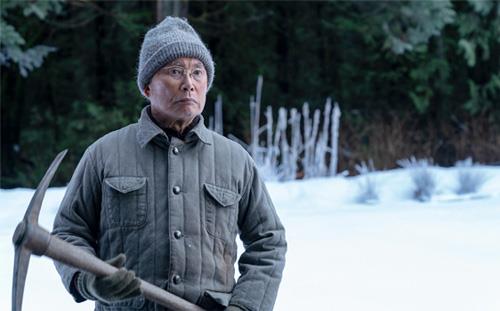
One horror turns to another on the second season of The Terror, AMC’s anthology series. While Season 1 was based on Dan Simmons’s 2007 novel of the same name about an ill-fated 19th century Arctic expedition, the second season turns to an era that was based on its own terror — the internment of Japanese-Americans in government camps during World War II.
The Terror: Infamy (AMC, 9 p.m. ET), as it is called, also has its terror element in the form of a malevolent spirit that traveled from the homeland of Japan.
In that sense, said AMC programming chief Dave Madden, it tells the story “through the lens of Japanese horror, also known as J-horror, similar in style of films like The Grudge and The Ring.”
But is the added scare necessary for a story that has its own historical horror?
For its added spookiness and gloss of mystery, The Terror: Infamy is one of the first movies or TV series to concentrate on that dark part of American history, for which the government finally apologized, generations later.
One of the biggest names in the cast is George Takei (top), still known for his role as Sulu on Star Trek, but who is also a leading social activist. He not only brings gravity to his role as a grandfather caught up in the internment but also personal history.
“I was five years old when I was imprisoned and eight-and-a-half when I came out,” Takei told critics at the TV Critics Association summer press tour.
The 82-year-old actor, who has recently also told his story in the best-selling graphic novel They Called Us Enemy, said he was struck by the authenticity of the internment camp set built in Vancouver.
“I immediately recognized it, but I recognized it from the standpoint of a five-year-old kid,” he said. “The look of everything was so authentic. It really took me back to my childhood.”
“This was one of the advantages of having George here,” says executive producer Alexander Woo. “The first day we shot in that mess hall, he said these dishes aren’t chipped enough. So we went and chipped a bunch of dishes so that we could have it completely authentic.”
But Takei said the ghosts in the production helped. “I see this show and the depth of authenticity in the show intensified by the Kaidan ghost tales,” he said. “It was a harrowing experience, but the Kaidan adds to the intensifying of that story to tell an engaging story.”
No doubt the horror element will bring viewers into a story not always told in American history class. But it may also resonate with today’s grim headlines.
“What we have is this endless cycle, the repetition of this kind of horror, injustice being inflicted on minority people, and we see it again today on our Southern borders,” Takei said. “But we’ve reached a new, grotesque low. We were together with our parents. Our families were intact. What we see today now is this incredible inhumanity of children being torn away from their parents and some being scattered in the outer far reaches of the United States from where they were torn away.
“So I hope this show, The Terror: Infamy, will remind people that it is still existing today,” he said. “It is our hope that enough people, enough Americans seeing this, will try to keep this sort of thing from recurring in the future of this country to make it a better, truer democracy.”
Woo said work on this season’s story began early in 2018 before the current immigration debate fully raged.
“The fact that we are at this moment in our history now makes it particularly poignant and relevant,” said Woo. “But George has been working to bring awareness to this story for decades because there is a lesson to be learned from this no matter what the current political situation is.”
And it goes beyond the United States, Takei said. “In Western China, the Uyghurs, Chinese Muslims, are being imprisoned in the, as they call it, ‘re-education camps.’ They are concentration camps.”
Madden said The Terror: Infamy goes out of its way to present historical accuracy, from the set and costume design to a large cast of actors of Japanese descent. “Our lead, Derek Mio, is a fourth-generation Japanese-American whose grandfather lived on Terminal Island and was sent to an internment camp after Pearl Harbor,” he said. “Director Joseph Kubota Wladyka’s grandfather was at Hiroshima when the atomic bomb dropped.”
“It’s a once in a lifetime role,” said Mio, “to play a character that is pretty much a composite of my grandfathers.”
In addition, a first assistant director Jason Furukawa had his parents interned in the same Canadian camp where they shot. “At the end of the safety meeting, he said, ‘And by the way, my parents were in stables seven and eight.’ They were in those horse stables,” Woo said.
“After we wrapped, one of the background actors said to me, ‘My parents never talked to me about the experience of the internment.’ Which is a common thing. They didn’t want to pass on the suffering,” Woo said.
The actor was surprised to be in “in the exact same place his parents were seventy-five years ago,” Woo said. “He’s a man in his 60s now. And he never thought he would experience that, certainly working as background he never thought he would experience that. It’s one of probably a hundred stories we could tell of why this show was so special to us, this project was so special to us, and one that probably none of us, certainly I won’t ever get to experience again in my career.”